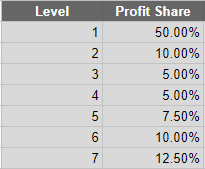To recruit real estate agents into Keller Williams, the company offers a profit sharing program. The Keller Williams profit share plan is meant to be an additional revenue stream for real estate agents that help grow their market centers, or the brokerage where they work.
Profit sharing plans aren’t a new concept. It’s a surprise to most, but Keller Williams isn’t the first one to create a profit share plan. They’re not even the second, third, or fourth.
They are, however, the first real estate brokerage to effectively use a profit share plan to recruit agents and grow to one of the largest real estate companies by agent count.
In this post, we’re going to explain the Keller Williams profit share plan, how it works, and why — quite frankly — it sucks.
We’ll go over some examples to give you an idea of potential agent earnings that the Keller Williams profit share plan offers. I’m also going to introduce you to an alternative revenue stream in real estate that offers more potential and benefits.
How The Keller Williams Profit Share Works
The Keller Williams profit share plan is a seven-level deep sponsorship plan that pays agents a percentage of a market center’s profit based on a sponsored agent’s production relative to the market center’s company dollars.
Wow. That’s a lot to unpack.
At a high-level, the profit share plan works like this: When a market center (brokerage) is profitable, those profits are split between the agents and the owners. The portion that is split with the real estate agents of the company is divided up based on the seven-level profit share tree and agent production.
If this model sounds a little bit familiar, it’s because the founder of eXp started his career at Keller Williams. The eXp revenue share program is modeled closely after the Keller Williams profit share plan.
Let’s unpack the profit sharing plan a bit more.
Keller Williams Profit Share Tree
Understanding how the profit share plan works, starts with understanding the profit share tree.
Each agent has a profit share tree that is seven levels deep; allowing agents to earn a percentage of profit off agents they directly recruit into Keller Williams and agents that their recruits recruit into Keller Williams.
Example: You recruit Lars into Keller Williams. Lars becomes your direct recruit and part of your first-level profit share tree. Agent Lars goes out and recruits Kyle into the company. Kyle becomes part of your second-level profit share tree and is also in agent Lar’s first-level profit share tree. If Kyle recruited an agent, that agent would be part of your third-level.
It goes on like that until you build a profit share tree that is seven levels deep. At that point, any additional agents added to the company won’t have a direct affect on your profit sharing amount. You won’t earn any profit share off agents that are deeper than your seventh-level.
Each level of your profit share tree offers a different percentage bonus. For example, in your first level, you get 50 percent of the profit that is attributed to your direct recruit at Keller Williams.

In your second level, it’s 10 percent. Here is a chart of the profit percentage that is allocated to you based on where a recruit is in your profit share tree.
The Profit Share Pool
When a market center produces a profit every month, only a portion — called the profit share pool — is shared with the real estate agents in the company. The exact amount of the profit share pool will vary based on how much profit the brokerage made.
Generally, in examples published by Keller Williams, they use a 48-52 percentage split. Roughly 48 percent goes to the profit share pool for the agents and 52 percent goes to the owners.
But, finding the percentage breakdown is a bit more complicated than that.
For the first $2,990 in profit, only 25 percent is allocated to the profit share pool. The next $8,250 of profit results in 35 percent going to the profit share pool. Anything above a total of $11,240 will be at a 50 percent rate.
Examples of Profit Share Pool
Let’s run through some examples to get an idea of the percentage breakdown of the profit share pool.
Let’s say a market center generates $30,000 in profit for the month. The first $2,990 is at a 25 percent allocation, so $747.50 goes to the profit share pool. The next $8,250 is split at 35 percent, so $2,887.50 goes to the profit pool.
Anything above $11,240 is split at 50 percent. In this case, the remaining $18,760 results in an additional $9,380 in the profit share pool. The grand total of the profit share pool is $13,015.
In this example, the profit sharing split is roughly 43 percent to the agents and 57 percent goes to the main owners of your Keller Williams market center.
Now, let’s say the profit is only $10,000 for the month. In this case, only $3,201 is allocated to the profit share pool. Here we have a profit share split of roughly 32-68. A far cry from the 48-52 split the company often promotes.
To get close to a 48-52 split, a market center generally needs to generate over $60,000 a month in profit or $720,000 per year. For more context, this brokerage would produce around $180-Million per year in production.
If you’re going to work for a KW, be aware that a brokerage under $180-Million in production likely has a profit share pool split that is less than 48-52.
Of course, this isn’t a hard and fast rule. For example, a brokerage that produces no profit, won’t contribute any money to the profit share pool.
Finding The Agent Profit Share
Okay, so how much actually goes to the agent for recruiting other agents into the company? To figure that out, we need to know the market center’s profit share factor. A profit share factor will determine how much is distributed to an agent’s profit share tree.
Example: The market center has a profit share factor of 0.25 and the total of the profit share pool for the month is $1,000. In this case, $250 will be divided among Lars’ direct sponsors and those who indirectly sponsor him through their profit share tree.
The profit share factor is calculated by taking the profit share pool amount and dividing it by the total market center dollars.
Generally, if a brokerage is operating efficiently and profitability, they should be able to create a 50 percent profit margin where roughly 30 to 40 percent is distributed to the profit share pool.
That means a good estimate for a profit share factor is 0.15 to 0.2.
Once we determine how much is distributed to a specific profit share tree, the amount that goes to each level is based on the percentages we discussed above.
In the case of Lars, his direct sponsor will get 50 percent of $250, or $125. His second level sponsor will get 10 percent, or $25. Third and fourth levels get 5 percent, or $7.50. It goes on like that until the seventh level.
Keller Williams Profit Share Examples
To get a better idea of potential earnings that the Keller Williams profit share plan offers, let’s dive into some more examples.
In order to do this, there needs to be some assumptions that are made and variables that are held constant. First, we’re going to take an average agent production of $2.6-Million.
Second, we’re going to assume an average profit share factor of 0.25, this is higher than what I often see for a market center, but aligns with many of the examples published by Keller Williams.
Third, I created a column called “max payout”. It’s important to understand that the profit share amount given to an agent is based on the profit share factor and the amount an agent pays — in the form of commissions, desk fees, and miscellaneous fees — to the market center.
Since Keller Williams has a cap, there comes a point where an agent is contributing little to the market center, and therefore, there is no profit share distribution made to real estate agents that have a capped agent in their profit share tree.
Example: an agent caps and only pays $20,000 to the market center. At this point, an agent is only contributing fees to the company. These really only add up to pennies every month.
So, I’m leaving them out for simplicity of the formula. In the spreadsheet, I’m operating under a $20,000 market center cap, which tends to be the average across all franchises. We’re also going to assume a 70-30 split for all agents.
Example #1 – Level One
Alright, let’s go with a simple example and look only at the first level of the profit share tree.
Let’s assume you directly recruit three real estate agents into Keller Williams. They become part of your first-level profit share tree and you will get a 50 percent bonus on the amount that is distributed to the profit share tree.
All three of your real estate agents go out and produce $2.6-Million. Given our variables and assumptions described above, your total potential earnings for the year would be around $7,500.

That’s not too bad.
Depending on your market, that’s equivalent to selling one to three homes. In this case, the profit distribution could be 10 percent or more of your total income for the year.
Now, let’s add some more real estate into your profit share tree.
Example #2 – Four Levels Deep
Now, assume you’ve grown and you managed to add 10 real estate agents into your first-level, 30 agents in your second-level, 90 agents in your third-level, and 150 agents in your fourth-level.
That’s an impressive profit share tree.
Again, assume every agent has a production of $2.6-Million and the profit share factor remains the same.
In this example, the profit share tree generates $100,000 in additional income.

Now we’re in six figure territory. That’s pretty impressive, right?
Well… maybe not when you add in some comparison context. Sure, six figures in additional, almost passive income sounds amazing, but what are the other options out there?
The Exit Formula: A Better Model
The Keller Williams profit share plan is attractive, but there is a far better model. It’s the Exit Formula.
Keller Williams’ profit share plan has some major disadvantages and downfalls. We’re going to cover some of those and show you why the Exit formula is a better model if you’re interested in building additional revenue streams in real estate.
Exit Realty’s formula is a single-level revenue share plan — rather than a profit share plan — that pays sponsors a 10 percent bonus on their sponsored agent’s gross commission income, up to $10,000 per year.
Example: Bill sponsors Cade into Exit Realty. Cade goes on to produce $80,000 in gross commission income. In this case, Bill gets a 10 percent bonus on the GCI or $8,000.
The revenue share versus profit share is a HUGE and critical difference.
Profit Share Is Risky For You
The biggest disadvantage to the Keller Williams profit share plan is that it’s contingent on a market center’s performance and financial management.
If a market center has no profit for the month, you don’t get anything.
There are several cases where a market center may fail to turn a profit in a given month. For example, some of it could be natural economic or seasonal cycles.
In states like Michigan, the real estate market comes to a grinding halt. As a result, it’s hard to produce a profit for the months of December, January and February. These are usually poor cash flow months.
No homes are selling, so no money comes in. But, the money still goes out. This results in no monthly profit and no profit share.
It could also be caused by economic conditions. In a down market, all real estate brokers struggle to turn a profit.
When you probably need the money the most, you won’t get any bonus from your profit share tree.
On the other hand, a revenue share plan, like the Exit Formula, isn’t reliant on the performance of the broker. Slow seasons or economic downturns don’t matter. As long as your sponsor is out there selling homes, you will get your bonus.
Even when economic conditions are good, a brokerage can still have no profit. The market center may decide to invest its extra cash into growth. Maybe they update their website or embark on expensive marketing campaigns to recruit new real estate agents.
With the Exit Formula, you don’t have to worry about these things.
Now, let’s turn our attention to some of the numbers behind the Exit formula and compare it to the previous Keller Williams profit share examples.
Example #1 – Level One
In our first example, the Keller Williams profit share plan generated an extra $7,500 per year for a real estate agent. Under the Exit Formula, a real estate agent generates an additional $23,400 per year — an amount that is three times more than the Keller Williams profit share plan.
At an average agent production of $2.6-Million, the average real estate agent generates $78,000 in gross commission income. With a 10 percent bonus, up to $10,000 per year, the direct sponsor will get $7,800 per average agent they sponsored into Exit Realty.

So, in our example, three agents with average bonuses of $7,8000, results in a $23,400 bonus payable to the agent’s sponsor.
Clearly, when we’re talking about direct sponsors into the company and don’t consider a profit tree, Exit Realty is a far better real estate broker.
Example #2 – Four Levels Deep
In this example, we managed to recruit nearly 280 real estate agents into Keller Williams and generated $100,000 in income from our profit share tree.
With the Exit Formula, the net earnings come out to $78,000 — a $22,000 difference.

Remember, Exit Realty offers only single-level residuals. Meaning, sponsoring bonuses are only paid on direct sponsors. In this case, it would be ten direct sponsors at an average $7,800 bonus.
This scenario makes the Keller Williams profit share plan seem like the best option.
But, is it really? I think to really compare these two income streams, we need to apply a deeper level of understanding.
We need to think in bets.
Thinking In Bets
There’s a great book by Annie Duke, called “Thinking In Bets”. The premise of the book is that we can make better decisions when we begin to think in probabilities.
In other words, we have to think about the probabilities of outcomes and ask ourselves what is the probability of a certain outcome?
Example: you can join a real estate brokerage that offers $100,000 in bonuses, but the probability of achieving the result is only 10 percent. Or, you can join a company that offers a bonus of $40,000, but the odds of success are 40 percent.
Which would you pick?
Annie Duke would argue that you pick the second brokerage.
You see, to think in bets, we need to take the outcome and multiply it by the probability to create an apples-to-apples comparison between different outcomes.
At the first broker, the value is only $10,000, or $100,000 times 10 percent. The second one is $16,000.
Brokerage two has a chance at a better outcome.
Understand the difference. We’re talking about the chance of a better outcome. Not absolute outcome results.
I know the first brokerage has a better outcome IF you’re successful. But, brokerage two has a chance at a better outcome, and therefore, the odds of being better off are with brokerage two.
Example Of Thinking In Bets
Apply this thinking above where Keller Willliams profit share plan resulted in $100,000 and Exit’s Formula netted $78,000.
To me, the probability of recruiting 280 agents into my profit share tree is far less than sponsoring 10 agents into Exit.
Say there is only a 5 percent chance of achieving the KW profit share tree, giving the example a $5,000 value ($100,000 times 5 percent). But, you give Exit’s scenario a 7 percent chance, or a $5,460 value.
In this case, even though Keller Williams seems better, Exit is worth more and has a better chance at a successful outcome.
Sure, part of the value in each example is going to be based on the probability you assign to each case. Let me tell you why the Exit formula has a higher probability than Keller Williams.
Contingent On Profits
We already mentioned this, but with the Keller Williams profit share plan, your bonuses are contingent on the market center’s profit.
No profit. No bonus. It’s as simple as that.
This contingency creates risk for a real estate agent. It increases the chance that a real estate agent won’t be able to achieve their projected results.
In all of the examples above, I had a profit share factor of 0.25. But what happens if the broker isn’t able to operate as profitability — for whatever reason — and the profit share factor drops to 0.20?

What went from an additional $100,000 income is now only an $80,000 income. In this case, there is only a $2,000 difference in outcome between Exit and Keller Williams.
If profits drop further, then the Exit formula will outperform the Keller Williams profit share plan.
As an agent, if I was thinking about joining my local Keller Williams, I would request to see their average profit share factor. Then I would analyze their management to determine if they will be able to achieve healthy profit margins.
If there is a lot of uncertainty or low profit share factors, it wouldn’t even be a debate. I would choose Exit Realty.
Recruits Must Recruit
A seven-level deep profit share tree sounds like an amazing thing, but few people really build out a strong profit tree.
That’s because you need to rely on your recruits becoming recruiters. We’ve looked at examples and know that the Exit formula outperforms the Keller Williams profit share plan on a direct sponsor basis.
In other words, if you fail to add agents to deeper levels of your profit share tree, then the Exit formula will outperform.
The people that are often able to build impressive profit share trees are those that get in early. They are usually the founders of the Keller Williams brokerage or one of the first few agents that joined when the company was new.
Today, it’s hard to build an impressive profit share tree, especially if your Keller Williams has been established for a while.
Turning recruits into recruiters isn’t easy. Most people get into real estate to be a real estate agent. Not a recruiter.
Odds are low that your direct recruits want to go out and recruit other real estate agents into Keller Williams.
Why Exit Formula Beats Keller Williams Profit Share
Let’s assume for a second I come up with examples where Keller Williams outperforms Exit Realty and I’m optimistic about probabilities at Keller Williams.
I still choose the Exit Formula. Earnings aside, there are other advantages the Exit Formula has over the Keller Williams profit share plan
Here are two reasons:
- It’s what is best for agents
- Death and retirement benefits
The Exit Formula Works For New Agents
Okay, you’re a new real estate agent and you’re trying to decide between Exit Realty and Keller Williams. You should join Exit Realty because the Exit formula incentivizes sponsors to train and mentor their real estate agents — allowing these new agents to earn more and increase their odds of success.
At Keller Williams, sponsoring agents are paid only a small portion of an agent’s production, and that assumes the market center makes an actual profit. There is some risk in the profit share plan.
It’s possible for a real estate agent to train and mentor their sponsored agent and get no financial benefit. If that’s the risk, do you think an agent will spend time mentoring an agent or going out and getting a listing?
I can tell you that Keller Williams agents aren’t as incentivized to mentor their sponsored agents due to this risk.
So, if you’re a new agent thinking about which company to join, understand that a sponsor at Keller Williams may not want to invest their time and resources into training and mentoring you. You will be on your own.
On the other hand, at Exit Realty, there is no risk to mentoring and training sponsors. Mentors get paid for investing their time and resources. It’s not contingent on a broker’s ability to turn a profit.
Sponsors at Exit Realty want their mentees to sell homes. It’s in the best interest of sponsors to train their agents.
If you’re a new agent, this means you’re more likely to get a hands-on, individual training and mentorship program. Something that is hard to find at any real estate broker.
Even if you don’t plan to participate in the Exit formula, it’s this formula that creates a collaborative culture and mentorship programs that many sponsoring brokers lack.
Say Bye When You Leave KW
Keller Williams used to offer lifetime eligibility for their profit share program, but in 2020 they got rid of it. Any real estate agent who joins after 2020 is only eligible for the profit share plan as long as you are working at Keller Williams.
If you decide to retire or you die, kiss those payments goodbye.
Imagine working hard to build your profit share tree and becoming reliant on that income. What would life suddenly look like for your beneficiaries if you died or you went into retirement?
All your hard work to build a profit share tree is gone.
And your beneficiaries pay the price. You might end up putting financial strain on them and cause them a lot of suffering in years to come.
At Exit Realty, there is a plan for retirement and your death. If you decide you want to retire, you can still receive a bonus of 7 percent of gross commission income produced by sponsored agents.
And if you die, your beneficiaries get 5 percent of gross commission income produced by sponsored agents.
So, even if you could make more from the Keller Williams profit share plan, the risk isn’t worth it.
Plus, do you want to join a company that is taking back some of the benefits to its plan? Who is to say that in three years Keller Williams doesn’t go out and lower the percentages paid into the profit share pool?
Nothing is stopping them. Exit Realty has never been involved in a take back situation with their Exit formula.
Final Word On Keller Williams Profit Share
The Keller Williams profit share plan is an outdated and limited method for generating additional revenue. There is too much risk when you need to rely on a market center’s financial management and ability to generate a profit. Even if they’re a great management team, you’re also betting on the market to continue to help the brokerage generate a profit.
Ultimately, there is a better model out there for real estate agents who are interested in sponsoring real estate agents into a company. It’s called the Exit formula.
For most agents, who typically only sponsor agents at a single-level, will earn far more from the Exit formula than a plan like the Keller Williams profit share plan.
With the risk and reliance on market center performance and Keller Williams taking away benefits to the program, I aligned myself with Exit Realty.
I wanted to also know that my family would be taken care of if something happened to me.
If you’re interested in learning more about the Exit Formula or joining Exit, I encourage you to reach out to me and schedule time for a chat. Shoot me an email at realtor@dolinskigroup.com




